Topics
Category
Era
St. Paul's Original High Bridge
When St. Paul's High Bridge opened in 1889, only one bridge in the United States surpassed it in height and length. Built of wrought iron and designed for wagons, the High Bridge served mainly cars and trucks. It was demolished in 1985 after ninety-six years of service.
Until 1874 the city of St. Paul consisted almost entirely of what is now downtown. In that year the city expanded south across the Mississippi River by annexing what became known as the West Side. This area included the lowlands just across from downtown (the Flats), the bluff top that rose to the south, Prospect Park, and Cherokee Heights, all the way to the Dakota County line at Annapolis Street.
Integrating this vast area into St. Paul (the annexation increased the city's physical size by more than a third) required bridges. The first Wabasha Bridge between downtown and the Flats had gone up in 1859. The original Robert Street Bridge, also from downtown to the Flats, opened in 1886. One area, the high bluff country around Cherokee Heights, remained cut off, almost two hundred feet above and nearly a mile west of the Wabasha Bridge and the Flats. This isolation impeded development.
Mayor Robert A. Smith pushed for a third bridge. Smith was also at that time a state senator, and in January 1887 the legislature passed his bill authorizing St. Paul to issue $500,000 in bonds for a new bridge to join Mohawk Street on the south with Forbes Avenue on the north. The city council rewarded Smith by renaming Mohawk and Forbes Streets Smith Avenue.
The project presented formidable challenges. Mohawk Street ended on a bluff almost 200 feet above the river, Forbes eighty feet above the river on the other side. A bridge between them would have to be very tall and also very long, so that the slope would be gentle enough to accommodate horse-drawn vehicles making the climb.
Andrew Carnegie's Keystone Bridge Company of Pittsburgh got the contract, though not without a lawsuit. Its bid exceeded the next bid by $29,000, and a group of citizens brought suit so the city would accept the lower bid. The lawsuit failed, as Keystone was determined to be the more capable contractor. Work began in July 1887 and finished in May of 1889 at a cost of $479,878.
The finished product—2770 feet long, 191 feet tall at its highest point, and made mostly of wrought iron—made the High Bridge a marvel of its time for the combination of height and length. (New York's Brooklyn Bridge, by comparison, completed six years earlier, is more than twice as long but only 127 feet above the East River.) Though painted red it was no beauty; asymmetrical, slanting, unadorned, the High Bridge was a nineteenth-century contraption built for utility.
Mayor Smith made the first buggy ride over it on May 17, 1889. Sightseers came by the thousands, first to see it, then to walk it, then to use it. It probably opened for general use in late May.
In August of 1904 a storm with winds measured at 180 miles per hour hit the city. It took down the south five spans of the bridge, about six hundred feet, spilling them into the Mississippi below. At a repair cost of $61,000, the bridge re-opened the following summer.
Built for a modest volume of slow-moving wagons, the bridge soon had to accommodate a high volume of cars and trucks. As early as 1915 engineers concluded that the High Bridge was not well suited to the automobile era. Nevertheless it operated with only short interruptions from 1905 to 1958, when it closed for four months for removal of the original cedar block decking, and repaving. (Cedar blocks had been chosen originally because they were quieter under wagon wheels.) It closed again for repair for six weeks in 1977.
By the early 1980s bridge inspectors knew that the High Bridge could not last much longer. Some parts had corroded dangerously; others meant to move and flex had become frozen. The Minnesota Department of Transportation closed it on July 25, 1984. Seventy-six pounds of plastic explosives brought it down on February 24, 1985, an event witnessed by a crowd of thousands. The new bridge, a more graceful double-arched span, opened in July 1987.
Bibliography
Bryan, Barbara and Constance Lepro. "Spanning a Century." Twin Cities (February 1985): 21–24.
http://www.writingthatmeansbusiness.net/img/articles/SpanningACentury.pdf
Hodapp, Susan. "Smith Avenue High Bridge (High Bridge)." Historic American Engineering Record MN-5, Typescript. Denver, CO: National Park Service, Rocky Mountain Regional Office, Department of the Interior, 1985. http://cdn.loc.gov/master/pnp/habshaer/mn/mn0000/mn0076/data/mn0076data.pdf
Millett, Larry. Twin Cities Then and Now. St. Paul: MNHS Press, 1996.
St. Paul's High Bridge 1889–1985, A Photo-Essay of the History of a St. Paul Landmark. Oakdale, MN: Minnesota Department of Transportation, 1985.
http://archive.leg.state.mn.us/docs/pre2003/other/851419.pdf.
Related Resources
Demlo, Paul. "St. Paul's High Bridge: Suicide Hot Spot." City Pages, February 6, 2008.
Hess, Jeffrey A., and Paul Clifford Larson. St. Paul's Architecture A History. Minneapolis: University of Minnesota Press, 2006.
“Thousands View Wrecked Bridge.” St. Paul Globe, August 22, 1904.
http://chroniclingamerica.loc.gov/lccn/sn90059523/1904-08-22/ed-1/seq-4/
"Some Firms Failed While High Bridge was Closed." St. Paul Pioneer Press and Dispatch, June 23, 1987.
Warner, George E., C. M. Foote, Edward D. Neill, and J. Fletcher Williams. History of Dakota County and the City of Hastings, Including the Explorers and Pioneers of Minnesota, by Rev. Edward D. Neill, and Outlines of the History of Minnesota, by J. Fletcher Williams. Minneapolis, MN: North Star Pub. Co., 1881.
http://books.google.com/books?id=XOEwAQAAMAAJ&q=west+st+paul#v=onepage&q=march%209%2C%201874&f=false
Related Images
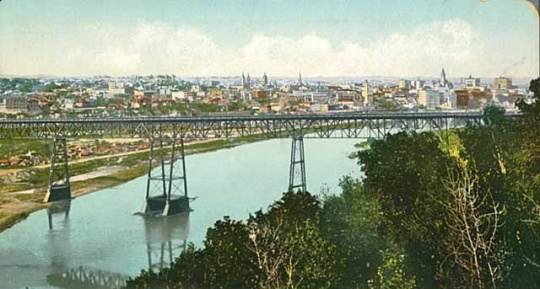
High bridge, St. Paul
Public domain
Holding Location
Articles
More Information
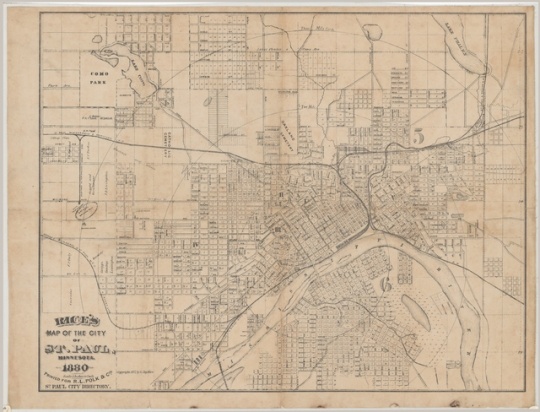
Rice's map of the city of St. Paul, Minnesota, 1880
Public domain
Holding Location
Articles
More Information
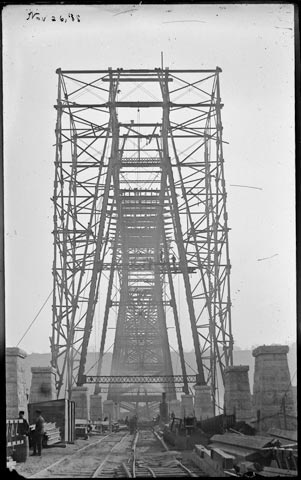
View of high bridge construction
Public domain
Holding Location
Articles
More Information
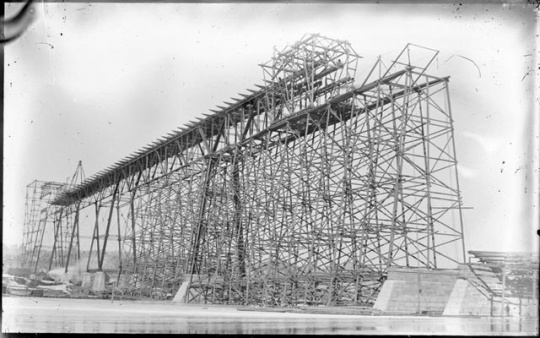
View of High bridge being built
Public domain
Holding Location
Articles
More Information
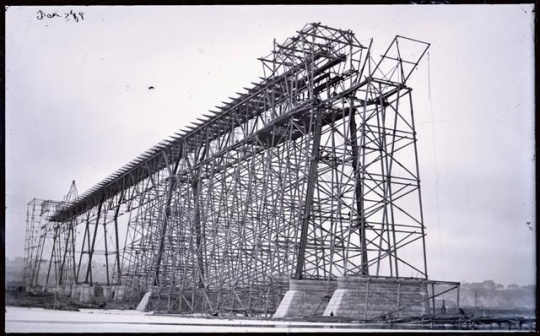
View of High bridge being built, St. Paul
Public domain
Holding Location
Articles
More Information
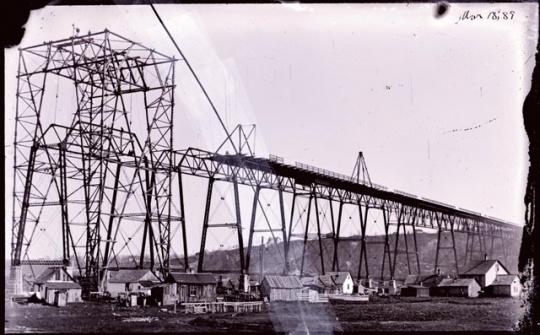
Construction of the first High bridge
Public domain
Holding Location
Articles
More Information
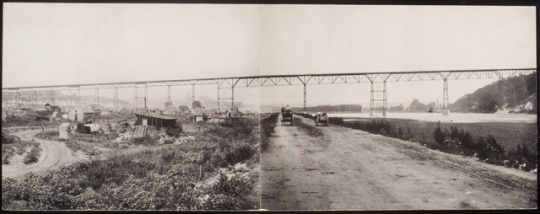
High bridge, St. Paul
Public domain
Holding Location
Articles
More Information
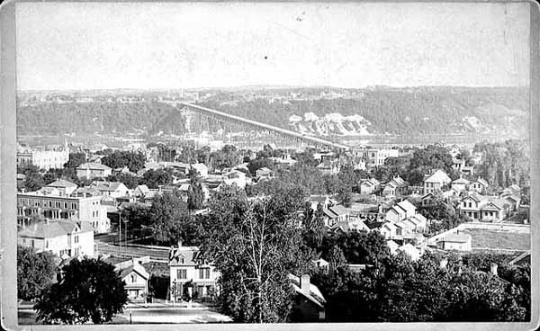
View of West Seventh area looking toward High bridge, St. Paul
Public domain
Holding Location
Articles
More Information
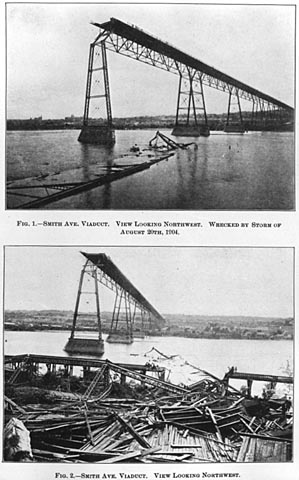
Smith Avenue viaduct (High Bridge) following storm, St. Paul
Public domain
Holding Location
Articles
More Information

Reconstructing the High Bridge partially blown down in the cyclone of 1904
Public domain
Holding Location
Articles
More Information
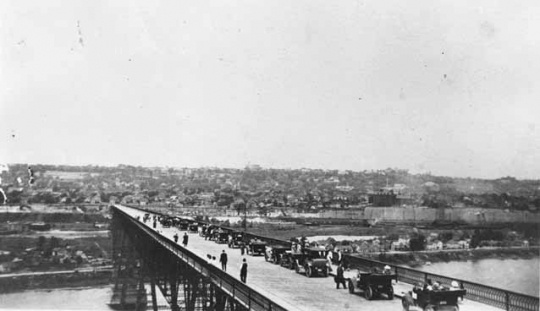
Reopening High bridge(?), St. Paul
Public domain
Holding Location
Articles
More Information
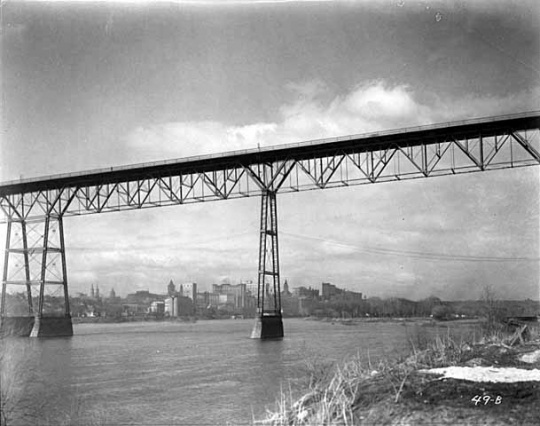
Looking northeast from west of the High bridge, St. Paul
Holding Location
Articles
More Information
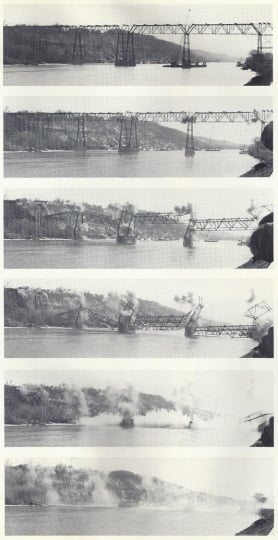
Demolition of the St. Paul High Bridge
Public domain
Holding Location
Articles
More Information
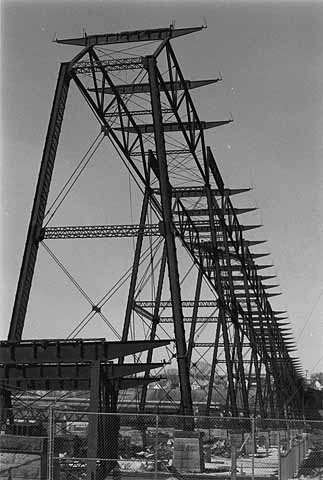
Remains of High bridge after demolition, St. Paul
Holding Location
Articles
More Information
Related Articles
Turning Point
On August 20, 1904, high winds break apart the south six hundred feet of the bridge, dropping them into the Mississippi River 190 feet below. The High Bridge reopens the next summer and stays open, with short interruptions, for seventy-nine more years.
Chronology
1851
1859
1874
1886
1887
1889
1904
1905
1958
1977
1985
1987
Bibliography
Bryan, Barbara and Constance Lepro. "Spanning a Century." Twin Cities (February 1985): 21–24.
http://www.writingthatmeansbusiness.net/img/articles/SpanningACentury.pdf
Hodapp, Susan. "Smith Avenue High Bridge (High Bridge)." Historic American Engineering Record MN-5, Typescript. Denver, CO: National Park Service, Rocky Mountain Regional Office, Department of the Interior, 1985. http://cdn.loc.gov/master/pnp/habshaer/mn/mn0000/mn0076/data/mn0076data.pdf
Millett, Larry. Twin Cities Then and Now. St. Paul: MNHS Press, 1996.
St. Paul's High Bridge 1889–1985, A Photo-Essay of the History of a St. Paul Landmark. Oakdale, MN: Minnesota Department of Transportation, 1985.
http://archive.leg.state.mn.us/docs/pre2003/other/851419.pdf.
Related Resources
Demlo, Paul. "St. Paul's High Bridge: Suicide Hot Spot." City Pages, February 6, 2008.
Hess, Jeffrey A., and Paul Clifford Larson. St. Paul's Architecture A History. Minneapolis: University of Minnesota Press, 2006.
“Thousands View Wrecked Bridge.” St. Paul Globe, August 22, 1904.
http://chroniclingamerica.loc.gov/lccn/sn90059523/1904-08-22/ed-1/seq-4/
"Some Firms Failed While High Bridge was Closed." St. Paul Pioneer Press and Dispatch, June 23, 1987.
Warner, George E., C. M. Foote, Edward D. Neill, and J. Fletcher Williams. History of Dakota County and the City of Hastings, Including the Explorers and Pioneers of Minnesota, by Rev. Edward D. Neill, and Outlines of the History of Minnesota, by J. Fletcher Williams. Minneapolis, MN: North Star Pub. Co., 1881.
http://books.google.com/books?id=XOEwAQAAMAAJ&q=west+st+paul#v=onepage&q=march%209%2C%201874&f=false















